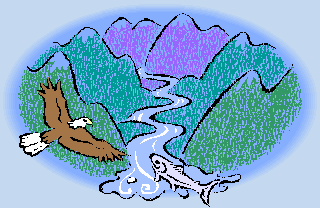Water
News for January 2013
While you were opening your Valentine cards, watching replay after replay of Senator Rubio taking a drink of Poland Springs, and waiting for the ax of Sequestration to fall, a lot of important things happened in the diverse and interesting world of water. Read on to hear all about it.
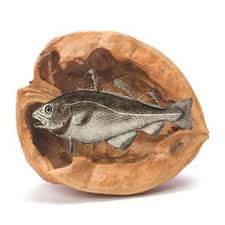 |
Water News in a Nutshell |
More Than 1,000 Communities Will Recover Part of the Expense Incurred Removing Agricultural Chemical from Water Supplies. The Maker of Atrazine Will Pay $105 Million, a Fraction of the Real Damage Done.
More than 1,000 communities that have spent millions of dollars over many years filtering a common agricultural herbicide, atrazine, out of their drinking water are welcoming their shares of a $105 million settlement with the weed-killer’s maker.
The lengthy suit has gone on for nine years. Atrazine’s maker, Swiss-based Syngenta, said it agreed to the settlement, approved in October by a federal judge in southern Illinois, “to end the business uncertainty” and avoid further legal costs. The company denied any liability or wrongdoing linked to the chemical, which it will continue to sell.
Research has shown runoff after rainstorms can wash the chemical into streams and rivers, where it can enter drinking water supplies.
The settlement money will go to community water systems that serve more than 37 million Americans, mostly in farming states. While some consider it “free money,” others said it’s only a pittance compared with what they’ve spent dealing with atrazine.
Most cities have expressed that the settlement reimburses only a fraction of the actual cost of treating their drinking water for atrazine poisoning.
Water suppliers from at least a half-dozen states — Illinois, Iowa, Indiana, Kansas, Missouri and Ohio — sued Syngenta for reimbursement of the cost of dealing with atrazine. $3.1 million going to Columbus, Ohio appears to be largest sum collected by a single city.
Atrazine is an herbicide used to control grasses and broadleaf weeds around row crops such as corn, sorghum and sugarcane. Its use has been banned in the European Union since 2003, but it remains the second most pervasive agricultural herbicide in the United States after glyphosate (Roundup®).
More details from ABC News.
More about atrazine from the Pure Water Products Contaminant List.
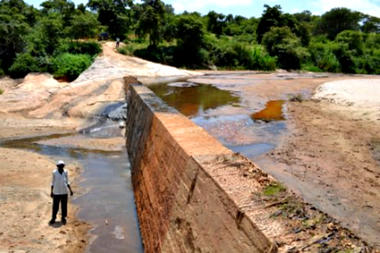 |
Simple devices called sand dams are being used in semi-arid regions of Kenya to provide year-around water for irrigation and domestic use. Water is captured during the rainy season for use during the dry season, which lasts for months. The unique feature of storing water in sand dams is that 60% of what is held is sand and only 40% is water.
Read more about sand dams in the Pure Water Gazette. |
The Rate of Decline of China's Water Supplies if Far Worse Than Was Believed. Coal and Chemical Concerns Now Use Up 1/4 of the Yellow River’s Annual Flow.
When 39 tons of the toxic chemical aniline spilled from a factory in Changzhi in China’s Shanxi province at the end of December, polluting drinking water for hundreds of thousands of people downstream along the Zhuozhang River and fouling the environment, it seemed a grave enough disaster. And it was.
But when Greenpeace China investigated they found something even more alarming. The fast pace of water consumption by coal and chemical industries in the area is drying up all water resources further downstream. In fact, by 2015, water consumption by coal and chemical industry in China’s dry, western areas is set to use up a whopping quarter of the water flowing annually in the nearby Yellow River.
According to Greenpeace, “Even more worrying than the chemical leak is the high water consumption of the coal and chemical industries in the area.”
None of this may be news to hardened followers of China’s crumbling environment, but the scale of the water consumption in the water-scarce area is nonetheless shocking: The Tianji Coal Chemical Industry Group, which caused the spill, consumes water equivalent to the consumption of about 300,000 people per year.
The coal and chemical industry is “a major water-eater.”
Water is a key challenge for the country, as rapid industrial growth guzzles water faster and faster. In the last 40 years, 13 percent of China’s lakes have disappeared, half its coastal wetlands have been lost to reclamation and 50 percent of cities left without drinking water that meets acceptable hygienic standards, the World Wildlife Fund said. The United Nations has singled China out as one of 13 countries with extreme water shortages.
Authorities agree that China’s water problems are complex. Although many small-scale conservation plans are underway, massive consumption by industries like coal and chemicals seems to present insurmountable obstacles.
Reference
Aeration Is a Green and Inexpensive Treatment for Common Well Water Problems
Iron, manganese, and hydrogen sulfide are common problems with well water. There are a variety of ways to treat them, but most involve using an “oxidizer” to prepare the targeted contaminant for removal by a filter. Chlorine, potassium permanganate, and hydrogen peroxide are often used as oxidizers, but one of the very best, the least expensive, and “greenest” is plain old air. Air can be applied to well water problems in a variety of ways. Read on for details. |
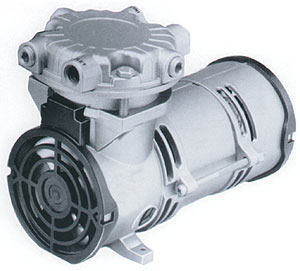 |
| Small air pump used to provide compressed air to oxidize water contaminants like iron and hydrogen sulfide. Modern air pumps are quiet, efficient, and inexpensive to operate. They provide chemical-free treatment for problem well water contaminants. More about aeration systems. |
Hardness. What Does It Mean?
Hardness in water is determined by the mineral content, specifically the amount of calcium and magnesium salts. Salts are formed when calcium and magnesium combine with bicarbonates, sulfates, chlorides, and nitrates. Hardness is a serious problem for homes and businesses because, among other problems, it forms damaging mineral deposits called scale to build up in pipes and appliances, shortening their lifespan and wasting energy.
The standard measurement of hardness in water is “grains per gallon,” with a grain representing 17.1 parts per million. Grains per gallon is usually reported “as calcium carbonate” (CaCO3) to facilitate comparison with other constituents of the water.
There are a variety of definitions of where “hard” water begins, but there is general agreement that water of 7 grains per gallon or more is hard enough that things would be improved by treatment.
Water Treatment for Hardness
The standard treatment for hardness is a water softener. It can treat up to about 100 grains per gallon of hardness, although it is less effective when a large amount of sodium is present.
A softener is not a filter but an ion exchanger. It exchanges sodium for the hardness minerals, calcium and magnesium.
Reverse osmosis also removes hardness, but reverse osmosis membranes are susceptible to scale, so using RO as a softening device is usually not practical. . Municipalities use a process called “lime softening” which lowers but won't remove hardness completely. Other alternatives to conventional softening include sequestering with polyphosphates and electronic- or media-based treatments that do not remove hardness but condition it to be less objectionable. Currently, TAC (Template Assisted Crystallization) technology is becoming the most commonly used alternative to conventional softening.
Worst Water Story of the Month
No question that the worst water story of the month was the endlessly repeated and exhaustingly discussed video account of Florida Senator Rubio's taking a drink of water during his peppy State of the Union rebuttal. I won't bother to link to it, since you already have watched it ad nauseam.
Close runners-up for worst story, however, deserve a link:
An angry Colombian wife dumped boiling water onto her husband's genitals as he slept after finding out he had been unfaithful. Doctors said his penis was “utterly destroyed.” Read more (if you dare).
An inspector for the federal Environmental Protection Agency was taken to the hospital after complaining of difficulty breathing while going through the Fall River water treatment plant. It was determined that his illness had nothing to do with anything that happened at the plant.
Read more.
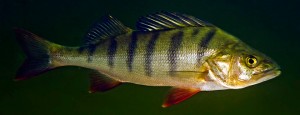
|
| Mind-altering drugs taken by humans are being excreted into lakes and steams. Swedish scientists studied the effects of these drugs on fish and found that they alter fish behavior and as a consequence change the environment. |
Pharmaceuticals Are Getting into Water and Changing the Way Fish Act
Psychiatric medicines that are excreted by humans and find their way into waterways can change the behavior of fish in rivers and streams, scientists report in a new study.
Researchers found that wild European perch exposed to the anxiety-moderating drug oxazepam in an experimental pond in Sweden were less fearful and are more aggressive feeders.
Ecologists worry that such changes in fish behavior could lead to unexpected ecological consequences, including changing the composition of species in waterways and increasing the risk of potentially toxic algal blooms.
“This is only one of hundreds of kinds of [pharmaceutical drugs] that are passed through wastewater plants, and we don’t know what their environmental effects will be,” said study coauthor Micael Jonsson, an ecologist at Sweden’s Umea University.
The new study, detailed in this week’s issue of the journal Science, also found that water downstream from sewage treatment plants in Sweden contain concentrations of Oxazepam that experiments have shown are capable of changing fish behavior.
The findings add to a growing body of evidence that pharmaceutical drugs can do more than just poison fish or change their physical characteristics. An earlier study conducted by scientists in Minnesota at St. Cloud State University showed that fathead minnows exposed to various antidepressants in the laboratory were slower at avoiding predators.
This latest study expands the list of mood altering chemicals to a different class of drugs – those used to treat anxiety disorders.
“Before this, people had talked at [scientific] meetings about how you would expect this kind of drug to affect fish behavior, but what these researchers have done is show, very elegantly, how fish behavior has changed, and not just one aspect either, but several aspects,” said Patrick Phillips, a hydrologist with the U.S. Geological Survey in Troy, N.Y., who was not involved in the study.
Perch are normally shy and hunt in schools. But Jonsson and his team found that those exposed to Oxazepam were bolder, less interested in hanging out with the group, and more likely to strike out on their own to explore novel, potentially dangerous areas.
“We were actually a bit surprised because [Oxazepam] is supposed have a soothing effect. Humans usually become calmer. But we saw the opposite in fish,” Jonsson said.
Normally, perch are constantly on the lookout for larger predator fish. The researchers speculate that the medicated perch are bolder because they are calmer.
“When they get exposed to this drug, they lose that inhibition, so they don’t care anymore,” Jonsson said.
Not only were the medicated perch braver, they also ate faster. In the long term, this combination of fearlessness and a larger appetite could lead to ecological disturbances that are hard to predict, scientists warn. Perch feed on tiny microorganisms called zooplankton, which in turn feed on algae.
“If the zooplankton decrease in number, the algae might increase, and you could have a situation where you have more algal blooms,” Jonsson said.
Alternatively, the perch population might actually decrease because drugs have made them foolhardy towards predators. But then again, “we don’t know how larger fish will react to this kind of medication,” Jonsson said.
There is also worry that some drug effects on wildlife won’t be apparent for years or decades.
“We’re just beginning to understand what the ultimate consequences may be from these kinds of exposures,” said research hydrologist Dana Kolpin, of the USGS Toxics Substances Hydrology Program, who also did not participate in the study.
According to scientists, it’s also likely that the ecological changes they worry about are already happening.
“It’s not all of a sudden that [medicines] are in the environment,” Kolpin said. “There are papers going back to the 1970s that say pharmaceuticals are potential environmental contaminants. We just didn’t have the analytical tools until more recently [to prove it].”
Most studies have shown that humans are unlikely to be affected by trace amounts of drugs in drinking water, but Kolpin suggests more research is needed.
“We just do not know enough about aspects such as sensitive populations” – including infants and pregnant women – “or effects from chronic exposures to complex chemical mixtures,” Kolpin said.
Jonsson and his team stressed that the solution to the problem is not to stop medicating ill people, but to develop ways for sewage treatment plants to capture environmentally hazardous drugs.
Experts say technology exists that can reduce, if not fully purge, drugs from waste water, but upgrading every waste treatment plant would be prohibitively expensive.
A more sensible, and realistic, approach would be to identify those classes of medicines that are most harmful to wildlife.
“We are realizing that some compounds are worse actors than others, and if we can identify those, then we can be more targeted in our approach for preventing their release into the environment,” Kolpin said.
Source: Inside Science. Reprinted here from the Pure Water Gazette.
Gazette Fair Use Statement
To find out which US city came out on top in the best municipal water competition at this year's Berkeley Springs International Water Tasting, go here.
Which diseases can you catch from drinking water that’s had a corpse floating in it?
By L. V. Anderson
Occasional's Introductory Note: The news this month of the discovery of a woman's body in a Los Angeles hotel's water tank raised
questions in many people's minds, mine for sure, about the health implications of drinking water with a human corpse floating in it. The body was discovered because hotel customers complained of low water pressure, not taste issues or illness.
I've wondered about this as long as I've know the cruel children's poem about the unfortunate Nell:
Tommy pushed his sister Nell
Down into our deep, deep well.
She's down there yet, they say it kilt her,
Now we have a water filter.
I 've always wondered what type water filter they got for their well. And should they have had a UV lamp as well? Slate has now set my mind at rest. --Hardly Waite.
The body of a Canadian tourist was discovered in a water tank on top of a Los Angeles hotel on Tuesday. Local health officials have ordered people not to drink the hotel’s water (though tests indicate that the water did not contain harmful bacteria). Would drinking corpse water make you sick?
Not necessarily. If the body belonged to a generally healthy person, you might get sick from E. coli or another coliform bacteria from the deceased’s intestine. But that’s unlikely. Most bacteria don’t survive long outside of the living human body, so pathogens would probably die in the water before they could do you any harm. Bacteria also thrive only within a certain temperature range, so hot or cold weather could hamper their spread, too. (A representative of the Los Angeles County Department of Public Health told NBC that a cold spell may have prevented the spread of bacteria in this particular case.) And since drinking water is treated with chlorine or other disinfectants for the express purpose of killing harmful fecal bacteria, dangerous germs have an even smaller chance of survival in a water tank than in, say, a lake.
However, coliform bacteria, which occur naturally in healthy people’s lower intestinal tract and feces, could conceivably diffuse through the water and survive long enough to make you sick. When ingested, coliform bacteria can cause diarrhea, vomiting, and other gastrointestinal symptoms, but they’re treatable with antibiotics.
If the body belonged to someone with an infectious disease, you might be in trouble. Hepatitis A, tuberculosis, cholera, and some bacteria that cause pneumonia can be spread through water, for instance. Some infectious bacteria, viruses, and parasites are chlorine-resistant, which makes them more dangerous in the water supply than coliform bacteria.
People who drink or bathe with water that’s been contaminated by a corpse are more likely to experience psychological effects than physical illness. Learning that you’ve inadvertently been in such indirect yet intimate contact with a dead body could be traumatic, and it may cause anxiety or post-traumatic stress disorder, both of which are treatable with psychotherapy or antidepressant or anti-anxiety medication.
WQA Aquatech USA 2013
The annual convention of the Water Quality Association of America will be held in Indianapolis this year, April 2 through April 5. The location is the Indianapolis convention center. The convention features conferences and product exhibitions and is generally regarded as the main event of the year for water treatment professionals.
More details from the WQA website.
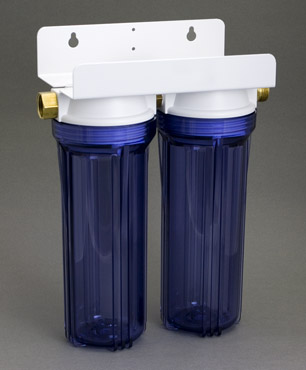 |
Official Garden Hose Filter Season Starts the First Week in March. Don't Be the Last on Your Block to Own a Garden Hose Filter.
Garden hose filters are among the most useful and the most versatile of water treatment devices. Today we had a call from a gentleman looking for a way to remove chlorine from the water he sprays on the logs he uses to grow mushrooms. Nothing easier. A simple garden hose filter (either a single unit, or a double, like the one pictured above) can remove chlorine easily when fitted with a good carbon filter cartridge.
In fact, carbon
can remove chlorine (or chloramines) from water used to fill fish ponds, provide clean and healthful water for horses and other four-legged creatures, water organic gardens, or fill the kids' wading pool. In addition to carbon cartridges, there are specialty filters to
keep hard-water spots off of cars, to remove sediment to protect sprinkler heads, to improve the taste and odor of drinking water for outdoor workers, or even to remove small amounts of iron or rust from water for hot tubs.
In short, garden hose filters have dozens of uses. They are simple, easy to maintain, and inexpensive to purchase.
We have them in four canister sizes, in single and double versions (we'll make a triple or quadruple upon request), and in three colors.
If you don't have a garden hose filter, it's really hard to understand why. There may be something wrong with you.
More details. |
Water News of the Month
Below are links to February's posts in the Pure Water Gazette's "Today's Top Water Stories" section. Some are included
in this newsletter. Reading the Gazette's daily posts will make you wiser and probably more popular.
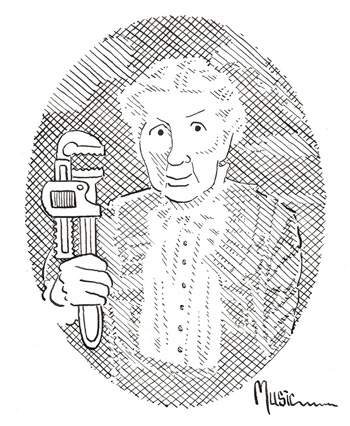 |
Water Treatment 101: Pressure, Flow Rate, and Delta P
by Pure Water Annie
Pure Water Gazette Technical Wizard Pure Water Annie Explains A Few Things About How Water Flows Through Pipes
|
Pushing high flows of water through a small pipe wastes both energy and money.
Water flowing through a pipe does not flow uniformly from edge to edge. Water in a pipe flows like water in a river, with water in the middle flowing much faster than water at the edges. Flow is fast at mid stream, and the water against the wall of the pipe is scarcely moving.
As water pressure pushing the flow increases, flow within the pipe becomes more turbulent and “thinner.” By thinner we mean that there is rapid flow at the center of the pipe but the areas of relatively low flow extend further
out from the walls of the pipe.
Flow with high turbulence requires far more energy than smooth flow. Thus, to double the flow rate in a pipe by increasing pressure, it takes four times as much energy. Therefore, it is important to limit linear flow when designing a piping system.
There is a general rule that says flow through a pipe should be no more than 8 to 10 linear feet per second.
There is a measurement used in pipe and water filter design called “Delta P.” In general terms, Delta pressure, or Delta P, most commonly refers to the difference in pressure before and after a fluid filter (oil, hydraulic, or fuel) which indicates when the filter is clogged. Most aircraft have “Delta P” indicators to show this condition. With water filters a pressure gauge is sometimes mounted in front of a filter and another after. The difference between the readings of the two gauges indicates the Delta P. If the filter is clean, the gauges should read nearly the same, but as the filter takes on contaminants, the difference between the inlet and the outlet gauges, the Delta P, increases.
There is a common misconception that pipe capacities increase in direct proportion to the stated size, i.e. that a 2” pipe has twice the carrying capacity of a 1” pipe, and that, therefore, two 1” pipes side by side would have the same fluid carrying capacity as a single 2” pipe. This is not true.
Without getting too technical, consider these examples:
If you put 10 gallons of water per minute through 100 feet of 1” irrigation pipe, the pressure at the end of the pipe will be 15 psi less than the pressure at the input end. That’s a Delta P of 15 psi per 100 feet of pipe.
If you put 10 gallons of water per minute through 100 feet of ¾” irrigation pipe, the pressure at the end of the pipe will be 20 psi less than the pressure at the input end. That’s a Delta P of 20 psi per 100 feet of pipe.
If you put the same 10 gallons of water per minute through 100 feet of 1/2” irrigation pipe, the pressure at the end of the pipe will be 35 psi less than the pressure at the input end. That’s a Delta P of 35 psi per 100 feet of pipe.
Another example:
Water flowing through a 10 foot section of 4” pipe at the rate of 10 feet per second will put out 400 gallons per minute.
Water flowing through a 10 foot section of 2” pipe at the rate of 10 feet per second will put out 100 gallons per minute.
Water flowing through a ten foot section of 1” pipe at the rate of 10 feet per second will put out 25 gallons per minute.
Therefore, a 2″ pipe is much larger than double the size of a 1″ pipe when it comes to flow and pressure performance.
Indebted to a Water Conditioning and Purification article by Chubb Michaud. Paper issue for February 2013.
Gazette Fair Use Statement
Pure Water Gazette Now in a New Format
Our information-stuffed variety magazine, the Pure Water Gazette, has taken another turn. The Gazette started as a paper publication in the 1980s. The last paper issue was mailed in 1997. It has existed since as an information-rich website whose navigation and aesthetic properties were suffering from years from neglect. Although the old site can still be seen here, the best of the old content has been relocated to a much more manageable and search-friendly blog-style format. The new site is up and running as a work in progress with
over 400 articles and many more to come. At least one new article is added each day. The new site is at the old location, http://www.purewatergazette.net. Please visit!
|
